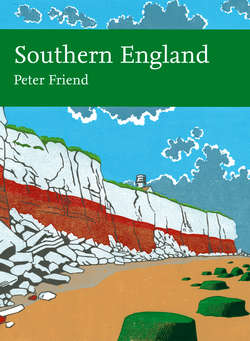Читать книгу Southern England - Peter Friend - Страница 17
SEA-LEVEL CHANGE
ОглавлениеThe coastline is the most recently created part of the landscape, and the most changeable. This is due, in large part, to the rise in sea level over the last 20,000 years, since the last main cold episode of the Ice Age (the Devensian). Twenty thousand years ago sea level was 120 m lower than it is today because of the great volumes of water that were locked away on land in the world’s ice sheets (Fig. 20). Land extended tens or hundreds of kilometres beyond the present-day coastline, and Southern England was linked to northern France by a large area of land (Fig. 21). Global climate started to warm about 18,000 years ago (Fig. 13) and the world’s ice started to melt, raising global sea level. The North Sea and the Channel gradually flooded, and Britain became an island between 10,500 and 10,000 years ago. This flooding by the sea is known as the Flandrian transgression and was a worldwide episode.
FIG 20. Graph of sea-level rise over the last 18,000 years.
During the period of most rapid sea-level rise (between 12,000 and 8,000 years ago), areas of low-lying land were swamped and some local features of the coastal scenery moved great distances geographically towards their present positions. The sea cliffs, beach barriers, salt marshes, spits and estuaries that can be seen today have only taken up their present positions over the last few thousand years, as sea-level rise slowed.
In the treatment of the Regions and Areas in the rest of this book, maps are presented that distinguish a coastal flooding zone. This presentation is based on the simplifying assumption that the solid Earth movement of Southern England (i.e. any uplift or subsidence, see Chapter 3) has been very small compared with global sea-level changes. The coastal flooding zone is defined as extending between the submarine contour 120 m below present sea level and the contour 20 m above present sea level, and it can be used to identify parts of landscapes which are likely to have been areas of coastline activity in the recent past. Areas of land with an elevation between present sea level and 120 m below sea level correspond to the land submerged during the last 18,000 years of sea-level rise. Areas lying at, or up to, 20 m above present sea level may have been subjected to coastal processes during the highest sea levels of earlier interglacial periods, such as the Ipswichian (see Fig. 13). The coastal flooding zone also defines areas of land that are most likely to become submerged during predicted future rises of sea level.
FIG 21. Two episodes (17,000 and 12,000 years ago) in the rise of sea level around the North Sea area. (Redrawn and simplified from Current Archaeology 207, 2006, Gaffney)
Drowned valleys (Figs 22 and 23) are present on the coastlines of Southern England as a result of recent sea-level rise. Formerly, the rivers draining the majority of these valleys would have transported mud and sand to the sea, where it would have been deposited on the sea bed. However, with the rise in sea level mud and sand are now often deposited in the flooded valleys or estuaries instead, and some have developed carpets of sediment, transported down-valley by rivers or brought up-valley by the sea where tides and storms have been effective.
Coastlines with low seaward slopes and a soft surface blanket and/or bedrock may develop beach barriers when flooded by rising sea level. These barriers are ridges of sand or gravel parallel to the general trend of the coastline (Fig. 24). They are created by the impact of storm waves on the gently sloping and soft landscape. They tend to develop a cap of wind-blown sand which is very vulnerable to storm wave erosion, but may eventually become stabilised by vegetation. Behind the barrier a low-lying area of more sheltered conditions develops and regular flooding at high tide may bring in muddy sediment from the sea that can settle and build up salt marshes.
FIG 22. The drowning of a valley by sea-level rise.
FIG 23. Drowned valley of the Deben, Suffolk, viewed from above the sea off Felixstowe Ferry. (Copyright London Aerial Photo Library)
FIG 24. Cross-section of a beach barrier formed as sea level rises over a very gently sloping landscape.
FIG 25. Beach barrier on Scolt Head Island, Norfolk. (Photograph held at Cambridge University Collection of Air Photographs, Unit for Landscape Modelling)
The aerial photograph of part of Scolt Head Island (Fig. 25) in north Norfolk shows the succession of zones parallel to the coastline typical of a recently flooded, gently sloping landscape. On the beach, coast-parallel ridges and hollows (runnels) have been created during recent storms, and are draining water as the photograph was taken at low tide. The crest of the barrier is capped by wind-blown dunes, which have been stabilised by marram grass, but also shows signs of erosion during recent storms. Behind the barrier are salt marshes, generally sheltered from storm waves and developing tidal channels. The salt marshes are forming around the remains of various sand and gravel spits that date from a landscape before the present beach barrier was there. The far side of the salt marsh is marked by a gently curved sea wall built within the last two centuries to reclaim some land by keeping high tides out. Behind that is the boundary between the present flat seaward zone of young sediment and the older terrain, marked by a complex field pattern that is underlain by Chalk bedrock.
